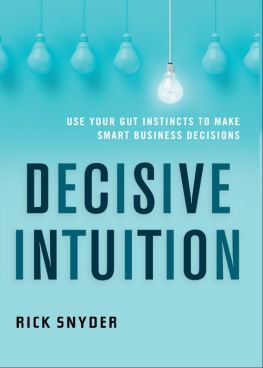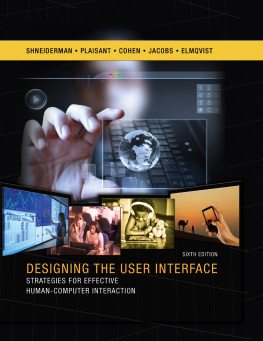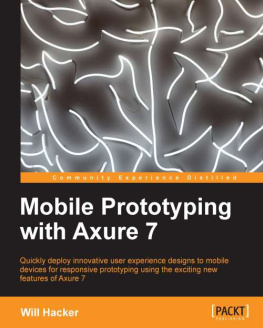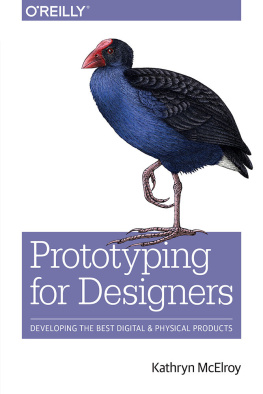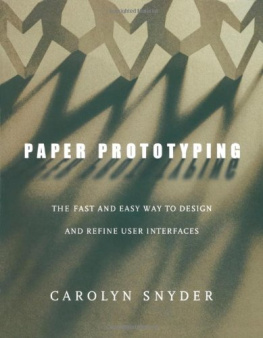Paper Prototyping
The Fast and Easy Way to Design and Refine User Interfaces
Carolyn Snyder
Snyder Consulting
Morgan Kaufmann
To my parents Clifand Lillian Snyder, who raised me with unconditional love, awesome siblings Nancy and Gordon, and self-affirming wisdom like You never know until you try Use your own good judgment Why dont you look it up? and Were you born on the side of the hill where the doors fell shut? (Well, maybe not that last bit.)
MK MORGAN KAUFMANN PUBLISHERS An Imprint of Elsevier AMSTERDAM BOSTON LONDON NEW YORK OXFORD PARIS SAN DIEGO SAN FRANCISCO SINGAPORE SYDNEY TOKYO
Publishing Director Diane Cerra
Publishing Services Manager Simon Crump
Editorial Coordinator Mona Buehler
Project Management Graphic World Publishing Services
Cover Design Yvo Reizebos
Cover Image Getty Images/Digital Vision
Text Design Rebecca Evans & Associates
Composition Rebecca Evans & Associates
Technical Illustration Graphic World Illustration Studio
Copyeditor Graphic World Publishing Services
Proofreader Graphic World Publishing Services
Indexer Steve Rath
Interior Printer The Maple-Vail Book Manufacturing Group
Cover Printer Phoenix Color Corp.
Designations used by companies to distinguish their products are often claimed as trade-marks or registered trademarks. In all instances in which Morgan Kaufmann Publishers is aware of a claim, the product names appear in initial capital or all capital letters. Readers, however, should contact the appropriate companies for more complete information regarding trademarks and registration.
Morgan Kaufmann Publishers An Imprint of Elsevier 340 Pine Street, Sixth Floor, San Francisco, CA 94104-3205
www.mkp.com
Printed in the United States of America
07 06 54
No part of this publication may be reproduced, stored in a retrieval system, or transmitted in any form or by any means-electronic, mechanical, photocopying, or otherwise-without the prior written permission of the publisher.
Permissions may be sought directly from Elseviers Science and Technology Rights Department in Oxford, UK. Phone: (44) 1865 843830, Fax: (44) 1865 853333, e-mail: by selecting Customer Support and then Obtaining Permissions.
Library of Congress Control Number: 2002115472
This book is printed on acid-free paper.
Foreword
Jakob Nielsen,
Principal, Nielsen Norman Group
Carolyn Snyder has written a wonderful book with all the practical information you need to make paper prototypes and get cost-effective usability data about your user interface designs. Any mid-sized design project will probably get an ROI of several thousand percent from following the advice in this book.
Yet, even though the book is great and the advice valuable and correct, there is a significant risk that you will put it all away and make this volume live out the rest of its life safely ensconced on a shelf. In my experience, paper prototyping almost never gets done in real design projects, despite its immense potential contribution to the quality of the ultimate user experience delivered by the project team.
Why dont design teams use paper prototyping? It is because it is so expensive and time consuming that the project manager regrettably made the decision to allocate the resources elsewhere and ship on time? No, paper prototyping is one of the fastest and cheapest techniques you can employ in a design process.
Paper prototyping isnt used because people dont think they will get enough information from something that simple and that cheap. It feels like you are cheating if you attempt make progress in your project without investing more of the sweat of your brows. Its too easy; it cant work goes the reasoning. Better to wait until we have a more perfect user interface before we show it to customers. Wrong. If you wait, it will be too late to translate the usability findings into the necessary change in direction for your design.
I am here to tell you that it does work. There are many different grades of paper prototypes, and they all give you immense value relative to the time they take to create and test. I have run studies where we had nothing but three different mockups of the homepage for a Web site and still learned a lot about how people would use the service and how the concepts communicated.
Twenty years of experience with usability engineering uniformly indicates that the biggest improvements in user experience comes from getting usability data as early as possible in a design project. Measured usability can increase by an order of magnitude when it is possible to change the projects basic approach to the problem, change the feature set, and change the user interface architecture. Usability insights also help later in the project, and there is value in fine-tuning details in the user interface, but the impact on the final user experience is not as great as the impact from fundamental changes made early in the design. Its a rough estimate, but I would say that the benefits from early usability data are at least ten times bigger than the benefits from late usability data. Late usability studies often add about 100% to the desired metrics for the final design, but early usability can add 1000% or more.
Forty years of experience with software engineering uniformly indicates that it is much cheaper to make changes to a product early in the development process. The most common estimate is that it is a hundred times cheaper to make a change before any code has been written than if the same change has to be made after the code has been completed.
Ten times bigger impact if the need for a design change is discovered early in the project. A hundred times cheaper to make the change. The experience from both fields is clear: Early is much better than late.
The benefits from early usability studies are so vastly superior that there is no doubt that you should use paper prototyping, even if you dont think the prototype is going to be as good as testing a fully developed design. If you try, you will be surprised at the amount of insights that can be derived from a primitive prototype, but even if you dont believe me, believe the collective experience of usability engineers and software engineers: Early beats late by so much that it outweighs the differences in quality of the prototypes.
Paper prototyping has a second benefit besides its impact on the quality of your current design project. It will also benefit your career. Consider all the other books you read about computers, Web design, and similar topics. How much of what you have learned from these books will still be useful in 10 years? In 20 years? In the immortal words of my former boss, Scott McNealy, Technology has the shelf life of a banana.
In contrast, the paper prototyping technique has the shelf life closer to that of, say, paper. Once you have learned paper prototyping, you can employ the technique in all the projects you do for the rest of your career. I have no idea what user interface technologies will be popular in 20 years, but I do know that it will be necessary to subject these designs to usability evaluation and that paper prototyping will be a valuable technique for running early studies.
Jakob Nielsen
Fremont, California
February 2003
Acknowledgments
It takes an entire village to raise an idiot. Oops, tangled metaphors, sorry. Ill start over.
It takes a whole professional community to support an author. Writing down everything you know about a subject is only the first step. Writing a good book means calling upon a whole raft of people to fill in all the holes in your knowledge and experience. Fortunately, the usability community consists of some of the nicest, smartest, and most helpful people I know.
Next page



